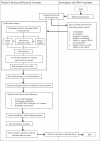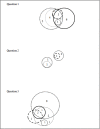Development of a Search Strategy for an Evidence Based Retrieval Service
- PMID: 27935993
- PMCID: PMC5147858
- DOI: 10.1371/journal.pone.0167170
Development of a Search Strategy for an Evidence Based Retrieval Service
Abstract
Background: Physicians are often encouraged to locate answers for their clinical queries via an evidence-based literature search approach. The methods used are often not clearly specified. Inappropriate search strategies, time constraint and contradictory information complicate evidence retrieval.
Aims: Our study aimed to develop a search strategy to answer clinical queries among physicians in a primary care setting.
Methods: Six clinical questions of different medical conditions seen in primary care were formulated. A series of experimental searches to answer each question was conducted on 3 commonly advocated medical databases. We compared search results from a PICO (patients, intervention, comparison, outcome) framework for questions using different combinations of PICO elements. We also compared outcomes from doing searches using text words, Medical Subject Headings (MeSH), or a combination of both. All searches were documented using screenshots and saved search strategies.
Results: Answers to all 6 questions using the PICO framework were found. A higher number of systematic reviews were obtained using a 2 PICO element search compared to a 4 element search. A more optimal choice of search is a combination of both text words and MeSH terms. Despite searching using the Systematic Review filter, many non-systematic reviews or narrative reviews were found in PubMed. There was poor overlap between outcomes of searches using different databases. The duration of search and screening for the 6 questions ranged from 1 to 4 hours.
Conclusion: This strategy has been shown to be feasible and can provide evidence to doctors' clinical questions. It has the potential to be incorporated into an interventional study to determine the impact of an online evidence retrieval system.
Conflict of interest statement
The authors have declared that no competing interests exist.
Figures


Similar articles
-
Comparing patient characteristics, type of intervention, control, and outcome (PICO) queries with unguided searching: a randomized controlled crossover trial.J Med Libr Assoc. 2012 Apr;100(2):121-6. doi: 10.3163/1536-5050.100.2.010. J Med Libr Assoc. 2012. PMID: 22514508 Free PMC article. Clinical Trial.
-
Using the full PICO model as a search tool for systematic reviews resulted in lower recall for some PICO elements.J Clin Epidemiol. 2020 Nov;127:69-75. doi: 10.1016/j.jclinepi.2020.07.005. Epub 2020 Jul 15. J Clin Epidemiol. 2020. PMID: 32679315
-
Utilization of the PICO framework to improve searching PubMed for clinical questions.BMC Med Inform Decis Mak. 2007 Jun 15;7:16. doi: 10.1186/1472-6947-7-16. BMC Med Inform Decis Mak. 2007. PMID: 17573961 Free PMC article. Clinical Trial.
-
Expediting citation screening using PICo-based title-only screening for identifying studies in scoping searches and rapid reviews.Syst Rev. 2017 Nov 25;6(1):233. doi: 10.1186/s13643-017-0629-x. Syst Rev. 2017. PMID: 29178925 Free PMC article. Review.
-
Sensitivity and predictive value of 15 PubMed search strategies to answer clinical questions rated against full systematic reviews.J Med Internet Res. 2012 Jun 12;14(3):e85. doi: 10.2196/jmir.2021. J Med Internet Res. 2012. PMID: 22693047 Free PMC article. Review.
Cited by
-
Search results outliers among MEDLINE platforms.J Med Libr Assoc. 2019 Jul;107(3):364-373. doi: 10.5195/jmla.2019.622. Epub 2019 Jul 1. J Med Libr Assoc. 2019. PMID: 31258442 Free PMC article.
-
Prevalence of Antibiotic Resistance in Older Adults and Alzheimer's Disease Patients: A Systematic Review and Meta-Analysis.J Alzheimers Dis Rep. 2024 Sep 10;8(1):1241-1251. doi: 10.3233/ADR-240057. eCollection 2024. J Alzheimers Dis Rep. 2024. PMID: 39434821 Free PMC article.
-
MEDLINE search retrieval issues: A longitudinal query analysis of five vendor platforms.PLoS One. 2021 May 6;16(5):e0234221. doi: 10.1371/journal.pone.0234221. eCollection 2021. PLoS One. 2021. PMID: 33956834 Free PMC article.
-
Interventions towards barriers to the practice of physical activity in adolescence: A systematic review protocol.PLoS One. 2023 Jul 12;18(7):e0287868. doi: 10.1371/journal.pone.0287868. eCollection 2023. PLoS One. 2023. PMID: 37437054 Free PMC article.
-
Transgenic rodents as dynamic models for the study of respiratory rhythm generation and modulation: a scoping review and a bibliometric analysis.Front Physiol. 2023 Dec 21;14:1295632. doi: 10.3389/fphys.2023.1295632. eCollection 2023. Front Physiol. 2023. PMID: 38179140 Free PMC article.
References
-
- Alper BS, Stevermer JJ, White DS. Answering family physicians’ clinical questions using electronic medical databases. J Fam Practice 2001;50(11):960–65. - PubMed
-
- Schwartz K, Northrup J, Israel N, Crowell K, Lauder N, Neale AV. Use of On-line Evidence-based Resources at the Point of Care. Fam Medicine 2003;35(4):251–6. - PubMed
MeSH terms
Grants and funding
LinkOut - more resources
Full Text Sources
Other Literature Sources

